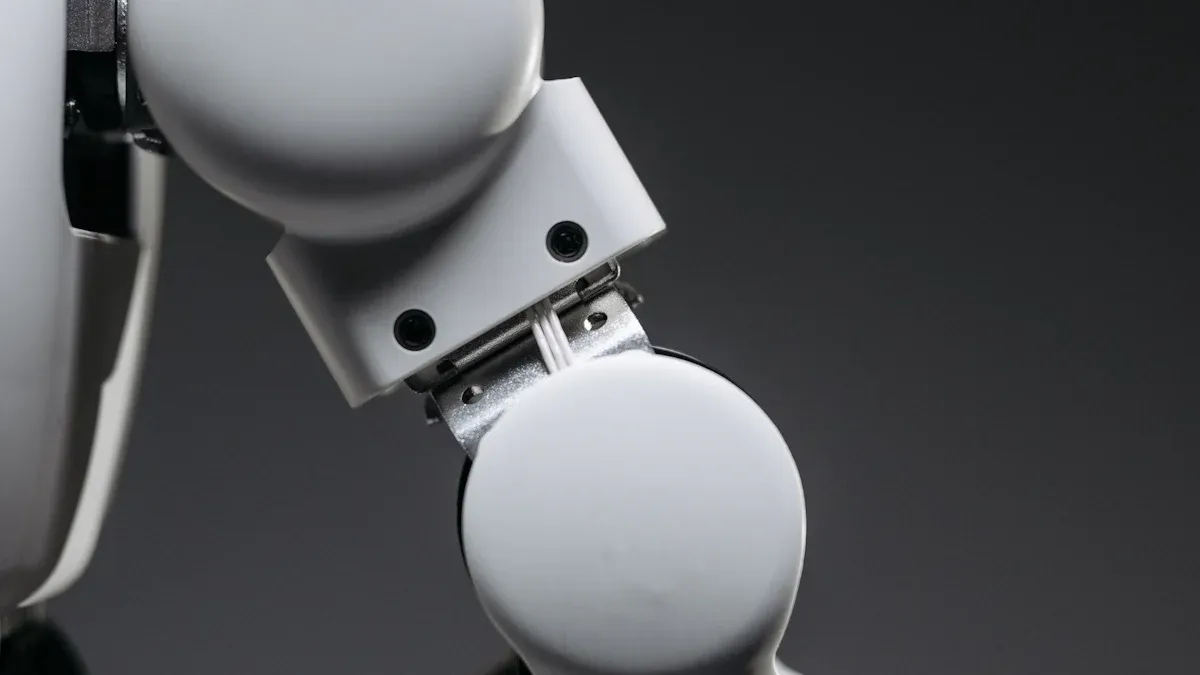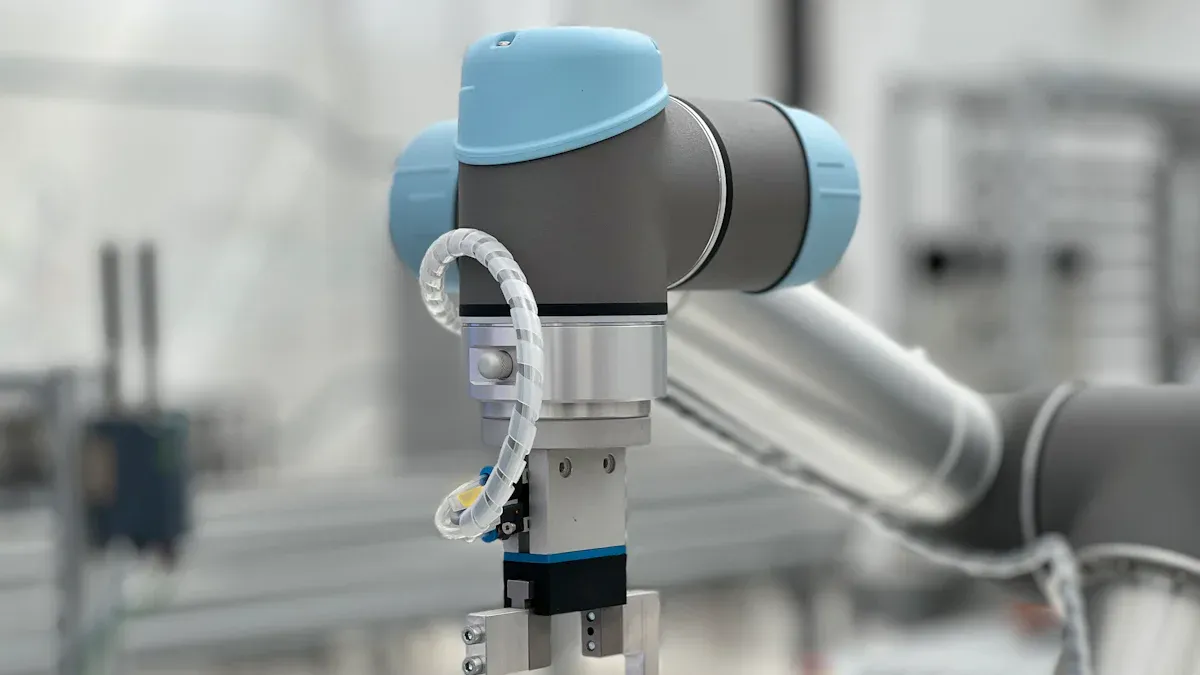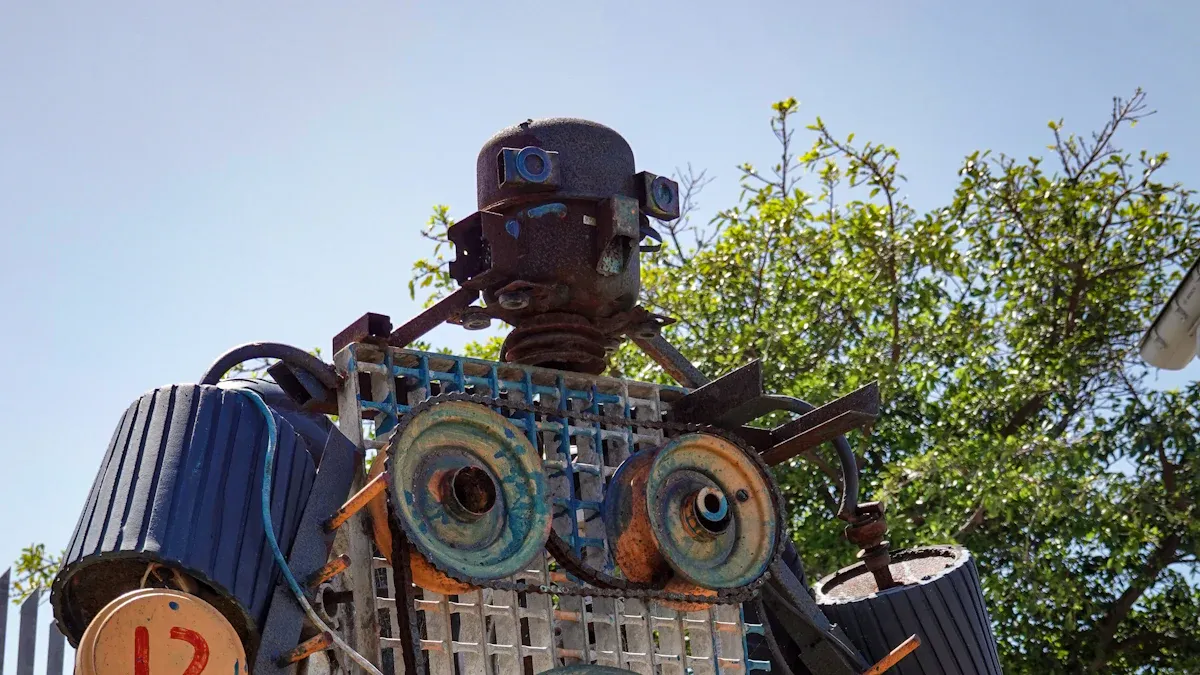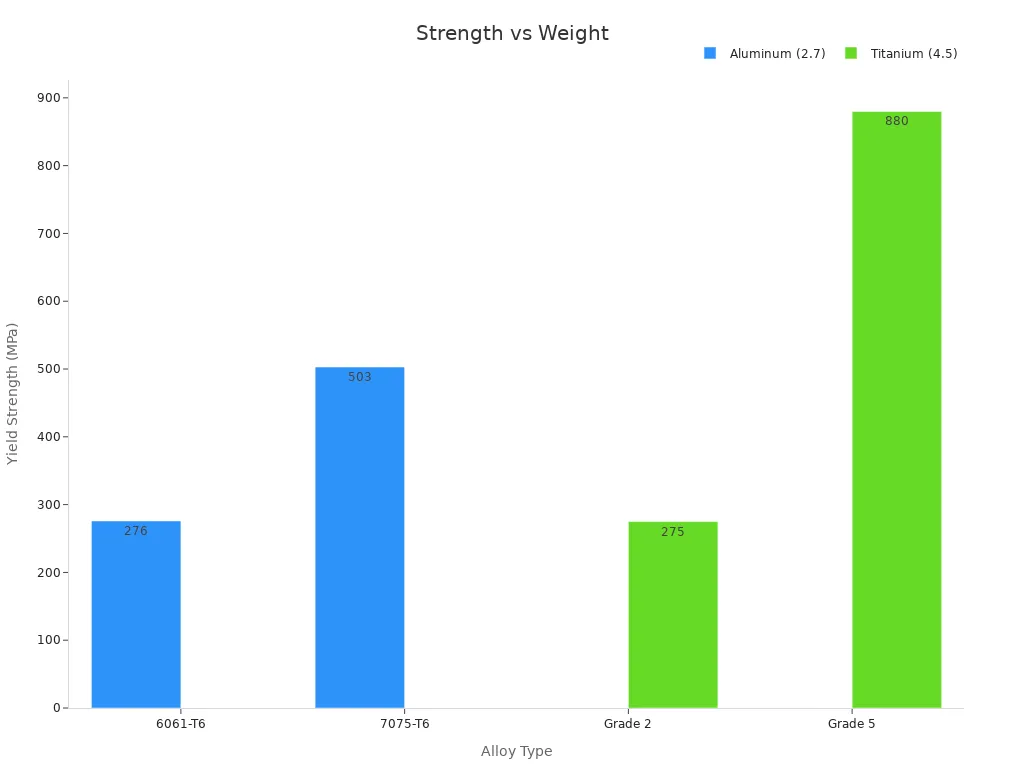Comparing Robotics Component Materials Steel Titanium and Aluminum

Choosing the best robotics component material changes how robots work and how much they cost. Robots made with good materials last longer and do their jobs better. Picking steel, titanium, or aluminum depends on what you need for strength, weight, how easy it is to shape, corrosion resistance, and price. The material you pick can change things like how often robots stop working, how much you spend fixing them, and how well they work. For example, robotic assembly lines have less downtime, going from 48 to 12 hours each month, and they spend less than half as much on repairs. Titanium is very strong and does not rust easily. Steel is the strongest but is heavy. Aluminum is light and costs less. Each material helps robots in different ways, so picking the right one is very important when designing robots.
Material Choice
Picking the right material changes how robots work and last. It also affects how much they cost. The material matters from the first model to daily use. Engineers must think about stress and corrosion. They want robots to keep working well. Trying out different materials helps teams test ideas. They can check if parts fit and see how robots act in real life. This helps lower risks and saves money. Modular designs and smart choices make repairs easier. They also help save money over time. Humidity or chemicals can hurt some materials. So, corrosion resistance is important for tough places. How a robot works is more important than how it looks, especially at first.
Performance Factors
Robots need materials that fit their jobs. Strength means how much force a material can take. For example, AISI 4130 steel is very strong. It is good for heavy-duty jobs. Weight is important because lighter robots move faster. They also use less energy. Aluminum is light and strong. Corrosion resistance keeps robots safe from rust. This is important in wet or salty places. Aluminum resists corrosion better than steel. Machinability means how easy it is to cut and shape a material. Easier machining makes building robots faster and cheaper. Cost matters, especially for big projects. Teams must balance all these things. This helps robots work well and last longer.
Factor | Steel | Titanium | Aluminum |
|---|---|---|---|
Strength | Very High | High | Moderate |
Weight | High | Low | Very Low |
Corrosion Resistance | Moderate | Excellent | Good |
Machinability | Moderate | Difficult | Easy |
Cost | Low | Very High | Low |
Application Needs
Different jobs need different materials. Industrial robots use steel for strength and long life. Medical robots use titanium because it is light and does not rust. Drones and light robots use aluminum to be fast and light. Soft robots use flexible materials for safety and movement. The material choice depends on stress and how long the robot will work. Robots in factories need strong materials for heavy loads. Robots in hospitals need safe and easy-to-clean materials. The way parts connect, like finger or dovetail joints, can change how well a material works. Softer materials absorb impacts. Harder ones give more stability. Picking the right material helps robots work better, last longer, and cost less.
Steel Robotics Component Material

Steel Properties
Steel is a very common material in robotics. It is strong and works well. Mild steel can hold about 250 MPa before it bends. It can stretch from 400 to 550 MPa before it breaks. This means steel can carry heavy things without breaking. The elastic modulus shows how stiff steel is. This changes with the type of steel and how it is made. For example, DP780 steel can lose 28% of its stiffness at 11% strain. Steel is heavy, with a density of about 7.85 g/cm³. This makes it heavier than metals like aluminum. Because it is heavy, steel is not good for fast robots or ones that need to save energy. But steel is very strong and stiff. This makes it great for parts that must not bend or break.
Property | Typical Value / Range |
|---|---|
Yield Strength | |
Ultimate Tensile Strength | 400 - 550 MPa |
Elastic Modulus | Varies; can decrease by 28% |
Density |
Steel Pros and Cons
Steel has many good points for robots. It is strong, so it helps with big jobs and large robots. Steel is easy to shape into complex parts. It does not rust fast, so it works well inside. Steel is not expensive, which helps big projects. Gas Metal Arc Welding (GMAW) makes building with steel fast and cheap. Powder bed fusion can make thin layers under 50 µm. This gives strong and exact parts. But steel is heavy, so robots may move slower or use more energy. Steel does not resist rust as well as titanium or aluminum. In tough places, steel needs extra coatings to stop rust. When steel cools, it can get stress that weakens it. So, engineers must design parts carefully.
Tip: If robots work in wet or chemical places, engineers add coatings to steel. This helps steel resist rust better.
Steel Uses in Robotics
Robotics teams use steel for frames, arms, and joints that need to be strong. Industrial robots use steel for their main parts. Steel is cheap, so it is good for making many robots. Steel lasts a long time and can take a lot of stress. It does not rust fast, so it works well in most factories. But it is not good for underwater or medical robots. When robots must lift heavy things or work in hard places, steel is a top pick.
Titanium Robotics Component Material
Titanium Properties
Titanium is a great material for robots. It is strong but not heavy. This metal is stronger for its weight than steel or aluminum. Titanium alloys like CP-Ti and Ti-6Al-4V do not break easily from repeated use. They can handle stress many times without failing. Titanium also does not rust, even in tough places like factories or outside.
Property | Material/Condition | Value | Notes |
|---|---|---|---|
Fatigue limit | RS CP-Ti (as-received) | 10^7 cycles, fully reversed loading | |
Fatigue limit | RS CP-Ti (annealed) | 490 MPa | Annealing increases fatigue limit |
Tensile strength | RS CP-Ti (as-received) | ~1040 MPa | High strength before annealing |
Tensile strength | RS CP-Ti (annealed) | 870 MPa | Slightly lower after annealing |
Yield strength (ultrafine) | CP-Ti (SPD processed) | Up to 1 GPa | Severe plastic deformation increases strength |
Note: Titanium’s high fatigue limit and strength-to-weight ratio make it perfect for moving parts that get used a lot.
Titanium Pros and Cons
Pros:
High strength-to-weight ratio lets robots carry more without being heavy.
Excellent corrosion resistance keeps parts safe in wet or chemical places.
Long-lasting parts mean fewer repairs are needed.
Cons:
Poor machinability makes it harder and more costly to shape.
Advanced simulations help plan how to cut titanium.
Titanium costs much more than steel or aluminum.
Titanium alloys like Ti-6Al-4V are good at handling repeated stress. Their tiny structure helps stop cracks from forming. Engineers use special models to guess how titanium will act when used again and again.
Titanium Uses in Robotics
Robotics engineers pick titanium for parts that must be strong and light. It is used in medical robots because it is safe and does not rust. Aerospace robots and drones use titanium for its lightness and strength. Underwater robots need titanium so they do not rust in saltwater. Even though titanium is expensive, it lasts long and needs less fixing, so it is smart for important parts.
Tip: Titanium is best for robots that work in hard places or need to move fast without extra weight.
Aluminum Robotics Component Material
Aluminum Properties
Aluminum is popular in robotics because it is light. It is much lighter than steel. Robots made with aluminum can move faster. They also use less energy. This helps engineers make robots that move easily. Aluminum moves heat away from motors and circuits fast. This keeps robots cool and stops them from getting too hot. Aluminum does not rust easily, even in wet places. Aluminum alloys are even stronger and last longer. Many teams pick aluminum for its good mix of strength, low weight, and rust resistance.
Key properties of aluminum:
High thermal conductivity (~235 W/(m*K))
Good machinability
Excellent corrosion resistance
Improved strength and wear resistance in advanced aluminum alloys
Aluminum Pros and Cons
Aluminum has many good points for robots. It is easy to cut and shape. This makes building robots faster and cheaper. Aluminum is strong for its weight and very exact. These things help when making robot arms and frames. Aluminum costs less than titanium. It is also easier to shape than steel. Robots made with aluminum use up to 25% less energy. Using recycled aluminum cuts waste by half at the end of a robot’s life.
Property | Aluminum (varies by alloy) | Titanium (Ti-6Al-4V) |
|---|---|---|
Density | ~2.7 g/cm³ | ~4.5 g/cm³ |
Tensile Strength | 110–700 MPa | 240–550 MPa |
Thermal Conductivity | ~235 W/(m*K) | ~22 W/(m*K) |
Machinability | Easier to machine | More difficult |
Corrosion Resistance | Good | Excellent |
But aluminum is not as strong as steel or titanium. It may not work for heavy robots. It also does not handle high heat as well as titanium. Still, aluminum is a good choice for most robots. It gives a good mix of strength, low weight, and rust resistance.
Note: Engineers often use aluminum alloys to make parts stronger and last longer. They do this while keeping the benefits of low weight and rust resistance.
Aluminum Uses in Robotics
Robotics teams use aluminum for many robot parts. It is used for frames, arms, and covers. Drones and moving robots use aluminum to stay light and fast. Medical robots use aluminum because it does not rust and is easy to clean. In factories, aluminum alloys help make strong and light parts. Research shows aluminum works well for drilling holes in robots. New ways of drilling make better holes and lower setup costs. Robots made with aluminum save energy and help the planet by using recycled materials.
Robotics Component Material Comparison

Strength vs. Weight
Strength-to-weight ratio is very important in robotics. Steel is very strong, but it is heavy. Heavy robots move slower and use more energy. Titanium is strong like steel but weighs less. Aluminum is the lightest, but it is not as strong as the others.
The table below shows how these materials compare:
Property | Steel (AISI 4130) | Aluminum Alloys (6061-T6, 7075-T6) | Titanium Alloys (Grade 2, Grade 5 Ti-6Al-4V) |
|---|---|---|---|
Density (g/cm³) | ~7.85 | ~2.7 | ~4.5 |
Yield Strength (MPa) | ~435 | Grade 2: ~275, Grade 5: ~880 | |
Tensile Strength (MPa) | ~560 | 6061-T6: ~310, 7075-T6: ~572 | Grade 2: ~344, Grade 5: ~950 |
Shear Strength (MPa) | ~435 | 6061-T6: ~207, 7075-T6: ~331 | Grade 5: ~550 |
Hardness (HB) | ~200 | 6061-T6: ~95, 7075-T6: ~150 | Grade 2: ~150, Grade 5: ~340 |
Grade 5 titanium has the best strength-to-weight ratio. Robots made with it can carry more or move faster. Aluminum is much lighter, so it is good for drones and moving robots. Steel is the strongest, but it is heavy. It works best for robots that do not need to move.

Note: Titanium’s great strength-to-weight ratio makes it best for high-performance robots that need to be strong and light.
Corrosion Resistance
Corrosion resistance keeps materials from rusting or getting damaged. Steel resists corrosion a little, but it can rust. It needs coatings to protect it in wet or chemical places. Titanium does not rust, even in saltwater or hospitals. Aluminum also resists corrosion, especially when anodized. This makes aluminum good for robots outside or in damp places.
Robots in factories with chemicals or outdoors do better with titanium or aluminum. Steel is best indoors or where it can be coated.
Machinability
Machinability is how easy it is to cut or shape a material. Steel is not too hard to machine, but it takes more time than aluminum. Titanium is hard to machine. It wears out tools fast and needs special care. This makes titanium parts take longer and cost more. Aluminum is the easiest to machine. It cuts fast and clean, saving time and money.
Tip: For quick building or custom parts, aluminum is the easiest to machine.
Cost Overview
Cost is a big part of picking a material. Steel costs the least. It is good for big projects or robots that need strong parts. Aluminum costs more than steel but less than titanium. It is a good mix of price, weight, and strength. Titanium costs the most. It is expensive because the material and machining are costly.
Material | Relative Cost | Best Use Cases |
|---|---|---|
Steel | Low | Heavy-duty frames, industrial robots |
Aluminum | Medium | Drones, mobile robots, medical robots |
Titanium | High | Aerospace, underwater, medical robots |
Robots that need to last a long time, like in space or hospitals, often use titanium even though it costs more. Most robots use aluminum because it is light, strong, and not too expensive. Steel is best for robots that need to be very strong and cheap.
Picking the right material depends on what the robot does. Titanium is best for strength-to-weight and corrosion resistance. Aluminum is best for easy shaping and low weight. Steel is best for strength and low cost.
Choosing Material
Picking the best material for a robot is important. The material changes how well the robot works and how long it lasts. It also affects how much the robot costs. Engineers think about things like strength, weight, and if the material can rust. They want robots to work well every day. Teams test different materials to see which one is best. They check if parts fit and how the robot moves. This helps them save money and avoid problems. Using smart designs makes fixing robots easier. It also saves money over time. Some places have water or chemicals that can hurt some materials. So, it is important to pick a material that does not rust easily. How the robot works matters more than how it looks, especially at first.
Picking the right material helps robots work better and stay safe. Steel, titanium, and aluminum are all strong in different ways. The best one depends on what the robot does and where it works. When teams use the right material, robots do more work and people get hurt less.
Application Area | Outcome | Cost per Employee |
|---|---|---|
CNC die press cutting of vinyl | Fewer injuries, higher productivity | |
Robot pick and place in microelectronics | Productivity increase | <$9,285 |
CNC stone cutting granite countertops | Lower risk, safer work | $11,543 |
Knowing what robots can do and how materials act helps teams make robots safer and better. Think about these things when you plan your next robot project.
FAQ
What makes titanium a good choice for medical robots?
Titanium does not rust and is safe for people. It stays strong even after many uses. Medical robots need parts that last a long time and do not cause harm. Titanium meets these needs.
Why do engineers often pick aluminum for drones?
Aluminum is light and easy to shape. Drones need to fly fast and use less energy. Aluminum helps drones move quickly and stay in the air longer.
Can steel be used for robots in wet places?
Steel can rust if it gets wet. Engineers add special coatings to protect steel. In very wet or salty places, titanium or aluminum works better.
Which material costs the most for robot parts?
Titanium costs the most. It is hard to shape and buy. Aluminum and steel cost less. Teams use titanium only when they need its special strength or rust resistance.
See Also
Comparing The Affordability Of Plastic And Aluminum Prototypes
Exploring The Advantages Of Black Anodized Aluminum Coating
How Magnesium Alloys Are Transforming Lightweight Production Methods
Importance Of Metal Substrates In Today’s Industrial Applications
A Guide To Aluminum Extrusion And Die Casting Techniques
About Hunan Puka
Established in 2016 and based in Hunan, China, with a liaison point in Berlin, we are a Tier 2 supplier for the automobile industry. We specialize in the production of customized aluminum die-casting parts designed for machines with a closing force ranging from 280 to 1250 tons, with subsequent manufacturing process CNC machining and surface treatment. Our commitment to quality is reflected in our accredited quality management system, certified by ISO9001:2015 and IATF16949:2016 standards.


